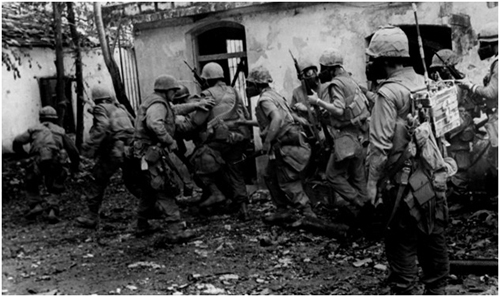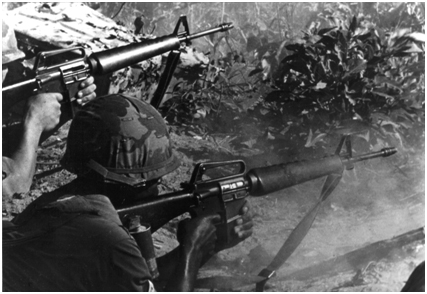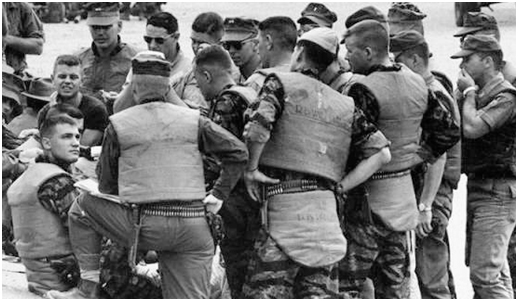7 Important Weapons Used By the United States in the Vietnam War
Sam Bocetta
War, what is it good for? Well, as it turns out, weapons development.
The Vietnam War saw the fastest rate of weapon development of any period since WWII. The ever increasing ferocity of the combat, and the body count, meant that unprecedented levels of resources were poured into weapon development.

Vietnam accordingly saw the perfection of many of the weapons of previous wars, with assault rifles in particular assuming their modern form during the conflict. It also saw the production of several totally new weapon systems, some of which would later go on to become standard military equipment, and some of which would never be seen again.
The multi-theater nature of the war also meant that the weapons that were developed applied to air forces as much as infantry troops, and as much to artillery as naval warfare. In fact, Vietnam necessitated a previously unknown level of cooperation between forces from various branches of the military, and the advances in weapon technology made by one branch were in some cases quickly carried over into others.
Today, I’ll take you through some of the most important weapons used during the Vietnam war. We’ll take a look at some artillery, the most effective aircraft used in the conflict, and some of the more strange ideas that arose during the war. First, though, let’s start with the humble …
Colt 1911
Yes, the Colt 1911 saw a significant amount of action during the Vietnam War. Though originally adopted for use in 1911, as the name suggests, this iconic design was to serve with the US military until 1986.
Having proved itself a reliable pistol in WW2, the US Military saw no reason to replace the pistol as a standard sidearm during the Vietnam conflict. In fact, during Vietnam the 1911s issued to US troops were essentially identical to those of WW2.
For those of you unfamiliar with this pistol, let me give you an idea of why it was used for so long. During the Philippine-American War way back in 1903, it was found that the then-standard infantry pistol, the .38 Long Colt, did not deliver enough power. Jungle warfare in the Philippines meant that most enemies were engaged at very close range and many soldiers took to carrying their sidearm in hand in case they were ambushed. The 1911 was Colt’s answer - chambered in .45 ACP, it delivered a huge amount of power at close range.

And of course, the same features that led to the 1911’s adoption in the Philippines also suited it very well to Vietnam. Not only was it powerful, but the sturdy construction meant that it put up very well with jungle conditions: many Vietnam veterans report that they were issued 1911s that were some 30 years old, and they still worked perfectly. For this reason, the 1911 remains popular today among beginner and advanced shooters alike.
M16
Ah yes, the M16. Arguably no infantry rifle has been more effective and more influential than this one. Though based on earlier rifles, the M16 represented a revolution in thinking about infantry weapons, and is still the base on which all modern infantry rifles are based. And though primarily a military weapon, it even came to influence civilian hunting guns, like the semi-automatic AR-15 rifle, which is largely based on this Vietnam-era gun.

At the very beginning of what would become the Vietnam War, back in 1954, US military advisors were armed for the first time. The weapon chosen was the 7.62mm M14 rifle. Though this rifle had proven itself up to that point, in essence the M14 was just a slightly adapted version of the Garand M1 rifle that had been used in WW2. As the Vietnam War intensified, it quickly became apparent that a better rifle was needed.
This rifle emerged in the early 1960s, after Kennedy committed more US military advisors to Vietnam. The Armalite Corporation re-thought the M1 in collaboration with Colt. The new rifle was lighter than the M1, weighing in at an impressive 6 pounds, and the gas system was heavily upgraded. Though initial trials of the new rifle indicated that it had some problems with jamming, especially when firing slightly damaged ammunition, some changes were made and the new design was standardized as the M16A1.
This M16, minus a few minor changes, is essentially identical to that still in use by US infantry forces today (though times are a-changin’). Developing 3,250 feet per second of muzzle velocity, and firing the devastating 7.62mm round, it proved a highly adaptable infantry weapon.
M-61 Grenade
Alongside their M16s, US infantry in Vietnam held a stock of M-61 grenades. This grenade was also of WW2 vintage, but similarly went through a significant period of development during Vietnam.

Since WW2, military thinking about grenades had stayed largely consistent – they were designed, made, and issued in two types, offensive and defensive. The offensive grenade was smaller and lighter, so that infantry soldiers could carry a good stock of them, though much less powerful than the defensive variant.
A kill radius of fifteen feet was considered optimal for offensive grenades, whereas seventy five feet was common for the heavier defensive variants. Offensive grenades had a flash and blast detonation, whereas the defensive grenades used a fragmentation design to generate plenty of deadly shrapnel.
The M-series of grenades was the primary set of grenades issued to US troops during the Vietnam conflict, and they came in a vast range of types and sizes. Vietnam saw the evolution of the humble grenade into several different types, each with dozens of variants. Chemical grenades were filled with white phosphorous in order to clear large areas of Viet Cong.
Incendiary grenades were primarily used to destroy equipment and building, utilizing a chemical fire to generate 4300 degrees fahrenheit of heat and start fires. Illumination grenades were extensively used by special forces, and could light areas of up to 600 feet for 25 seconds. Last, there was a whole variety of smoke grenades for signalling and screening, and in particular to show helicopters where to land.
Amongst all these M-series grenades, it is hard to choose the most important. However, I’ve gone for the M-61 because it was developed specifically for Vietnam. The M61 was essentially a M26A1 grenade, but with an extra safety attached to the arming lever. US soldiers called this the “jungle clip”, and you can probably guess why.
The most common method of carrying grenades was on straps on your ammunition pouches, and this was the recommended practice. However, soldiers were reported to also carry their grenades hooked into their belt or straps by the safety lever. If that sounds like a bad idea, it was – when trekking through the heavy vegetation of the Vietnamese jungle, grenades could be ripped off a soldier, armed, and deposited at their feet. This was why the M61 came with an extra safety.
The Patton 48
Vietnam is not a place for tanks. Covered in dense jungle and steep mountains, the armor tactics developed during Korea and WW2 were never going to work in Vietnam. Though you may have seen movies of tanks crashing through dense foliage, in reality the three-level canopies of the Vietnamese jungle made the use of tanks almost impossible.
That is, with the exception of one tank – the Patton 48 series. Though quite an old tank by the time of Vietnam, this vehicle was found to be the only one light, powerful, and maneuverable enough to be effective in combat.

Several adaptations were made to the basic tank, most notably the addition of a bulldozer front plate that could knock foliage and even trees out of the way. When used in this way, the Patton 48 was able to clear a relatively wide path through the jungle, and thereby provide a trail for infantry forces.
Six hundred Patton tanks were used in Vietnam, organized into 57 tank units at battalion level. They were used both offensively and defensively, carrying infantry into attacks but also used for mine laying and the defense of forward operating bases.
Though certainly effective, Patton crews often had reason to resent the visibility of their tanks. In a war fought largely in dense jungle, and between forces constantly trying to ambush each other, even a relatively small tank was easy to spot, and represented a grand prize for anyone who could disable it. Though the thick armor of the Patton was able to resist most RPG attacks, as time progressed the Soviets began to supply the Viet Minh with powerful anti-tank grenades that were able to disable the tank. The limited range of these grenades made their use a suicide mission, but in the end they accounted for a large number of destroyed Pattons.
Perhaps the most effective use of the Patton, however, and the one that represented something of an advance in use of armor, was the mounting of the M67 flamethrower on the main turret. With long-range engagements all but impossible, this weapon was used to clear jungle, and to engage enemy troops at short range. The marines, fighting alongside Pattons equipped with this flamethrower, called it the “Zippo”, after the brand of cigarette lighters.
The Flak Jacket
I know, I know, this is not a weapon. However, the humble flak jacket made such a contribution to the effectiveness of infantry troops in Vietnam that no list like this one would be complete without it.

Flak jackets were first introduced to the US Armed Forces in 1945, but the first versions of these were pretty ineffective against rifle rounds against anything resembling close quarters combat. The claustrophobic battles of Vietnam therefore spurred the development of extra protection. By 1962, flak jackets provided cover for the chest, abdomen, back, and neck against small arms fire and grenade fragments. These jackets were those used for most Marine and Army infantrymen and weighed approximately 10 pounds.
In the Air Force, both gunners and pilots were afforded a better level of protection. Gunners wore full body armor, and pilots only frontal protection, but these suits were far more rugged than those issued to the infantry. They had an extra inner surface of aluminium and ceramic, and legs were protected by steel plates. The weight of this full armor approached 25 pounds, however, and so was not practical for most ground troops.
Though the development of body armor is often overlooked in the history of weapon development, and this is a shame. This is because it is difficult to understand the ever-increasing power of small arms without looking at what they are designed to actually do – penetrate body armor. It is no coincidence that the M16, with a huge muzzle velocity in comparison to WW2-era weapons, was developed alongside effective body armor.
By the end of the Vietnam War developments in technology meant that body armor was more effective than ever before. Notably, the widespread use of Kevlar meant that the many of the Viet Minh’s rifles were not able to penetrate the armor of American soldiers, and forced them to upgrade their weapons.
Vietnam was arguably the conflict that cemented the place of body armor in modern infantry forces. Never again would marines or army infantry be expected to go into the field unarmored – just look at any picture of the wars in Iraq or Afghanistan for a good illustration of this.
M102 Howitzer
Though Vietnam is often thought of as an air war, in reality artillery was a far more important part of the US forces’ approach than Air Force bombers. In comparison to aircraft, US artillery could fire a much wider range of ammunition, fire more sustainably, and most importantly more accurately.

Accordingly, the number of artillery pieces deployed in Vietnam is surprisingly large. Eventually, there were some 69 artillery battalions engaged in the war, supporting 93 maneuver battalions. The tactics used were quite similar to previous conflicts – a generally equal distribution of direct fire guns and indirect fire howitzers, with speed of movement and engagement regarded as the most important aspect of each active unit.
Though it was widely reported that the Viet Cong feared artillery bombardment more than any other weapon used by the US, again the jungle presented difficulties for standard artillery tactics. Gunners and spotters were rarely able to engaged massed enemy formations, where explosive shells were most effective, and the dense canopy meant that spotting even individual targets was pretty difficult.
Manoeuvrability, both in deploying infantry and then using it, was therefore key. It was for this reason that the M102 howitzer was developed. In a good example of inter-branch co-operation, this howitzer was designed to be broken down and carried by helicopter to the front line. It could also traverse 360 degrees, making it highly effective in fast-moving battles.
Firing a new high-explosive artillery shell, this howitzer was also able to engage enemies at relatively close range, reducing the effectiveness of the Viet Cong tactic of “hugging” their forces close to US artillery.
The US Soldier and Marine

Of course, all of these weapons rely on another piece of highly advanced technology – the US Soldier and Marine. Though a lot of military history blogs, and perhaps this article included, tend to focus on the technology improvements in firepower during Vietnam (and other wars), it’s incredibly important to remember that it is the old-fashioned training, dedication, and sacrifice of our brave young men and women that our strength is built on, not on our fancy technology.
About the Author(s)
Comments
Pretty interesting read…
Pretty interesting read overall. I feel like inclusion of the Flak jacket not only is suitable, but would also love to read about more ingenious ways USA military adapted to harsh environment of Vietnam jungles: not just weaponry, but apparel, gear and ways to approach it. In my opinion, Vietnam war was a catalyst that developed not only military gear to be extremely universal in any weather or climate conditions, but also did the same to tactical and survival gear( https://gritroutdoors.com/outdoor-survival/ if you compared modern civilian survival gear, you'd find that it's just miles ahead of what army had during vietnam, while being used for mostly recretional use) available to normal people.
Quite a lot of this is full of errors. The M102 was introduced in 1964, which means it wasn't designed specifically for Vietnam, but probably more as a more airlift/airmobile-friendly artillery piece, as the Army started using more aircraft and helicopters for strategic and tactical movement. The flamethrower version of the Patton wasn't an advance in armor, but the end of a thread -- flamethrower tanks were in wide use during WWII, and IIRC, the Patton was the last U.S. tank to have a flamethrower variant.
"This M16, minus a few minor changes, is essentially identical to that still in use by US infantry forces today (though times are a-changin’). Developing 3,250 feet per second of muzzle velocity, and firing the devastating 7.62mm round, it proved a highly adaptable infantry weapon."
This is a bit confusing. I'm not aware of an M16 variant firing 7.62mm. H&K has the 417 in 7.62mm and FN has the SCAR-H in 7.62mm, but neither are M16s, or Vietnam era.

